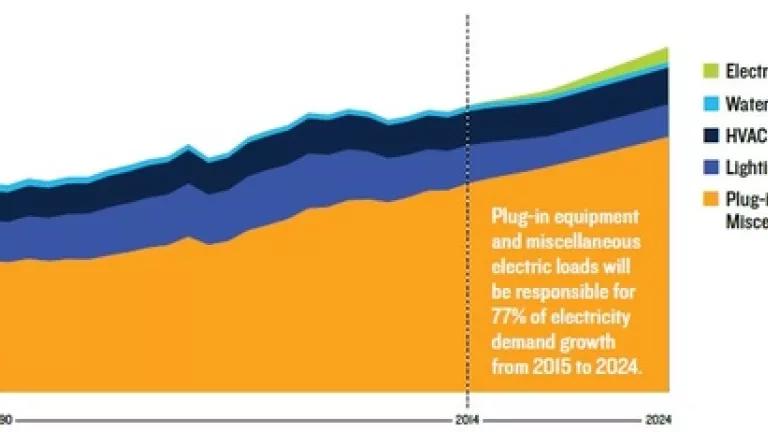Plug-in Equipment Efficiency Bill Could Save Californians Billions, Help Achieve the State's Climate Goals

With around 50 appliances, electronics, and miscellaneous electric devices connected to our household electrical sockets, plug-in equipment is responsible for approximately two-thirds of electricity use in California homes. Unfortunately, much of that is wasted due to inefficient and always-on devices. Californians can help solve this problem by urging their elected state representatives to pass California Assembly Bill 1094 to cut that energy waste.
The legislation also would be a major step in the state's drive toward reducing carbon pollution while putting as much as $250 back into the average household budget every year.
In fact, NRDC's analysis indicates that scaling up plug-in equipment energy efficiency could save Californians up to $4 billion per year in energy costs and reduce carbon pollution by 7 to 10 metric tons annually by 2030.
Helping low-income families
Plug-in energy waste can affect low-income communities particularly hard because it amounts to a larger share of their already limited disposable income. AB 1094 will help those households reduce how much they spend unwittingly to power devices that are not being actively used. That will leave more cash in their pockets to help them make ends meet. For example, utility energy efficiency incentive programs can help them replace older and less efficient equipment, such as the 25-year old energy-guzzling fridge and 10-year old computer, with newer, more efficient, and cheaper to operate models.
A key clean energy policy
AB 1094, authored by Assembly Member Das Williams and sponsored by NRDC, also represents an important implementation strategy for Governor Jerry Brown's recently announced goal to double energy efficiency in existing buildings by 2030, and for legislative proposals that would codify these goals into California law. AB 1094 calls for an analysis of plug-in electricity consumption, establishment of long-term statewide efficiency targets, and the development of a plan to achieve them. The bill passed the Assembly Utilities and Commerce committee today, but there are several other legislative hurdles ahead before it becomes law so it's important that lawmakers hear from constituents urging them to support this important clean energy bill.
So many devices, so much energy used
With the explosion in the number of devices in the modern home, plug-in equipment is now responsible for approximately two-thirds of all electricity use in California homes and is projected to account for most of the growth in electricity demand in the coming decade, according to the California Energy Commission's 2014 demand forecast.
The typical home has more than 50 plug-in devices - which are anything that plugs into a wall outlet. Plug-ins include computers and phones, TVs and tablets, game consoles such as the PlayStation, Xbox, or Wii, the coffee maker in the kitchen, as well as the traditional kitchen and laundry appliances such as refrigerators, washers and dryers. They even include vacuum cleaners, power tools, and hot water pumps in your furnace closet or garage.
At the office are "always-on" computers, printers and shredders, the photocopier, video conference equipment, signage displays and often data centers - plus the refrigerator, coffee machine, and microwave in the break room.
One factor is that appliances that once were mechanical-only, such as stoves and washing machines, now feature screens and electronic controls. And some remain connected to Wi-Fi or other home networks 24/7, which, if not implemented with efficiency in mind, can cause them to draw significant power around the clock. And yet, there are no general standards requiring that all of these new devices waste as little energy as possible.
A decade or more ago, the majority of electricity consumption in California homes came from heating, cooling, and lighting. Much progress has been made in these uses, reducing them to roughly one-third of energy use, thanks in large part to building codes and energy efficiency programs.
But the number of miscellaneous devices (also known as miscellaneous electric loads, or "MELs") has increased and is still growing so rapidly that whatever savings are achieved in heating, cooling, and lighting is being overwhelmed by the sheer number of plug-in devices. Given that California's climate and energy goals cannot be met by focusing mostly on just one-third of the problem, a stronger focus on the efficiency of appliances and MELs is necessary.
We need to move more quickly
While the state is making significant headway in some other areas of clean energy--such as renewable energy, electric vehicle deployment and building efficiency standards--there has been too little attention on plug-in equipment, allowing it to grow to an outsize share of overall electricity usage - a whopping two-thirds. And yet, plug-ins accounted for just 20 percent of electricity savings from efficiency programs and standards accordingly to the California Public Utility Commission's efficiency statistics portal --a clear disconnect.
Efficiency programs and standards for plug-in equipment need to be accelerated and scaled up to reach California's goal of reducing greenhouse gases by 80 percent by 2050.With ambitious climate and energy goals from both the governor and the legislature, now is the time for Californians to contact their state legislators and ask them to support AB 1094 to reduce electricity waste in plug-in equipment, help achieve the state's goals and lead the way for the rest of the United States and the world.
